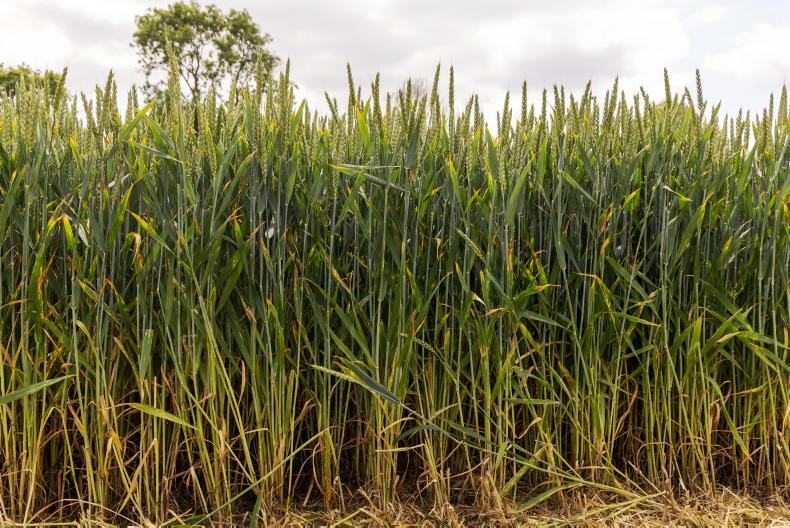Protect the chemistry continued to be the message at the Teagasc national tillage conference when it came to fungicides. Steven Kildea, Teagasc, research officer, was speaking in the context of septoria control on winter wheat crops, a disease that can dramatically reduce crop yields.
Steven said there have been major changes in fungicide programmes over the past three seasons.
Chlorothalonil went from the market and two new actives entered – Revysol and Inatreq. Keeping the new chemistry we have working as well as possible for as long as possible is essential.
The Teagasc researcher described “sensitivity” levels which is how diseases react to a fungicide. Some may be very sensitive and this results in good control of the disease, while others can lose sensitivity over time to result in reduced control of a disease. If septoria is sensitive to a fungicide, that fungicide will have some control over the disease, but levels of sensitivity can vary and change.
Teagasc has been identifying baseline sensitivity levels from before these new products came on to the market and for those new chemical actives on the market.
Inatreq was found to have a relatively narrow range of sensitivity and Steven explained that this would be expected as it is a completely new mode of action – a QiI.
When compared with some other countries like Germany and Denmark, for example, the data showed it was least sensitive to the chemistry here in Ireland. However, there were no signs of resistance to the chemistry and no differences in the efficacy of the product were found under glasshouse conditions.
Looking at Revysol, a large range in sensitivity was found. This would also be expected as Revysol is an Azole and this mode of action has been used for about 40 years. Again, the Irish data was shown to be least sensitive.
The good news is that Steven noted that no strains of Septoria have been found that are resistant to the new fungicide actives – Inatreq or Revysol. However, as both actives can be regarded as at a medium to high risk of resistance development they do need to be strongly protected.
In order to protect chemistry growers should:
Always use fungicides in mixtures which have different modes of action to target the disease.Inatreq and Revysol should only be used once each in a programme.Include a multisite fungicide – folpet – at the leaf three and leaf one timings.Make sure other diseases like yellow rust are also being targeted, where required.
Protect the chemistry continued to be the message at the Teagasc national tillage conference when it came to fungicides. Steven Kildea, Teagasc, research officer, was speaking in the context of septoria control on winter wheat crops, a disease that can dramatically reduce crop yields.
Steven said there have been major changes in fungicide programmes over the past three seasons.
Chlorothalonil went from the market and two new actives entered – Revysol and Inatreq. Keeping the new chemistry we have working as well as possible for as long as possible is essential.
The Teagasc researcher described “sensitivity” levels which is how diseases react to a fungicide. Some may be very sensitive and this results in good control of the disease, while others can lose sensitivity over time to result in reduced control of a disease. If septoria is sensitive to a fungicide, that fungicide will have some control over the disease, but levels of sensitivity can vary and change.
Teagasc has been identifying baseline sensitivity levels from before these new products came on to the market and for those new chemical actives on the market.
Inatreq was found to have a relatively narrow range of sensitivity and Steven explained that this would be expected as it is a completely new mode of action – a QiI.
When compared with some other countries like Germany and Denmark, for example, the data showed it was least sensitive to the chemistry here in Ireland. However, there were no signs of resistance to the chemistry and no differences in the efficacy of the product were found under glasshouse conditions.
Looking at Revysol, a large range in sensitivity was found. This would also be expected as Revysol is an Azole and this mode of action has been used for about 40 years. Again, the Irish data was shown to be least sensitive.
The good news is that Steven noted that no strains of Septoria have been found that are resistant to the new fungicide actives – Inatreq or Revysol. However, as both actives can be regarded as at a medium to high risk of resistance development they do need to be strongly protected.
In order to protect chemistry growers should:
Always use fungicides in mixtures which have different modes of action to target the disease.Inatreq and Revysol should only be used once each in a programme.Include a multisite fungicide – folpet – at the leaf three and leaf one timings.Make sure other diseases like yellow rust are also being targeted, where required. 








SHARING OPTIONS